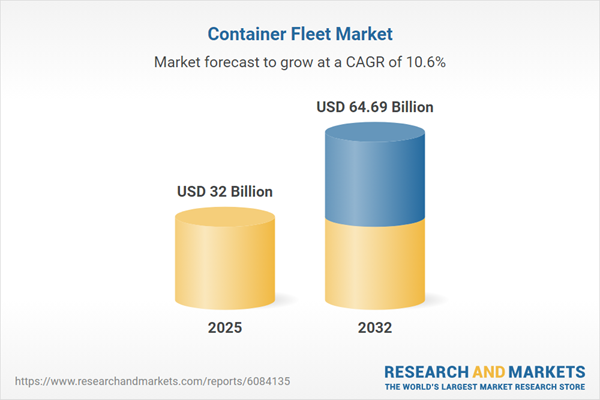Speak directly to the analyst to clarify any post sales queries you may have.
The global container fleet market is rapidly evolving as digital transformation, sustainability mandates, and geopolitical shifts reshape shipping and logistics strategies worldwide. For senior decision-makers, understanding these changes is essential to drive informed growth, enhance resilience, and optimize operational and investment decisions.
Market Snapshot: Container Fleet Market Growth and Outlook
The container fleet market grew from USD 28.87 billion in 2024 to USD 32 billion in 2025 and is expected to expand at a CAGR of 10.60%, reaching USD 64.69 billion by 2032. This growth trajectory is powered by continuous adoption of advanced technology and the expansion of global trade routes. Strategic priorities are shifting as market leaders leverage digitalization, decarbonization initiatives, and new regional trade patterns—ensuring continuity and flexibility in global supply chains through modernization and data-driven risk management frameworks.
Scope & Segmentation
- Container Types: Dry van containers are essential for transporting high-volume dry cargo efficiently. Refrigerated containers ensure temperature-sensitive goods, such as pharmaceuticals and produce, are moved reliably, with integrated cooling and advanced maintenance systems to reduce spoilage risk and maintain compliance.
- Ownership Models: Leased fleets offer operators maximum financial flexibility, helping them quickly access advanced equipment and technology when responding to fluctuating demand. Owned fleets allow organizations to tailor assets for specific operational needs, facilitating direct control over depreciation schedules and customization for specialized services.
- Applications: The sector serves varied demands, including automotive industries with just-in-sequence delivery needs, bulk liquid transport split between food-grade and industrial use, as well as chemicals and gases classified into hazardous and nonhazardous segments. General cargo focuses on packaging adaptability, while the movement of refrigerated goods spans fresh to frozen produce, each requiring unique handling standards and logistics protocols.
- Regions Covered: Market activities span the Americas, Europe, Middle East & Africa, and Asia-Pacific. Coverage reflects the influence of regional economic drivers, regulatory differences, and infrastructure maturity—from developed logistics hubs in North America and Western Europe to emerging trade corridors across Asia-Pacific and parts of Africa.
- Companies Profiled: The competitive landscape features key global players such as Mediterranean Shipping Company S.A., A.P. Moller – Maersk A/S, CMA CGM S.A., China COSCO Shipping Corporation Limited, Hapag-Lloyd Aktiengesellschaft, Ocean Network Express Pte. Ltd., Evergreen Marine Corporation, Yang Ming Marine Transport, HMM Co., Ltd., and Wan Hai Lines Ltd.
Key Takeaways for Container Fleet Market Stakeholders
- Digitalization and Internet of Things (IoT) integration improve real-time asset monitoring, enabling predictive maintenance and reducing unplanned downtime, which is vital for cost management and asset utilization.
- Sustainability efforts are driving widespread adoption of alternative propulsion systems, such as hydrogen fuel cells and biofuels, ensuring alignment with evolving emissions regulations and enhancing corporate social responsibility profiles.
- Increased focus on nearshoring and new regional trade agreements is shifting fleet deployment, prompting organizations to reexamine investment strategies for more adaptive fleet networks suited to new consumption and sourcing patterns.
- Strategic collaborations between technology firms and fleet operators are producing advanced analytics capabilities in route planning and container tracking, equipping decision-makers to optimize routes and mitigate unpredictable supply chain conditions.
- Market segmentation by equipment type and ownership model enables more refined capital allocation and supports compliance with differing regulatory regimes, supporting safety and efficiency priorities across commodities and regions.
- An integrated approach to technology and sustainability adoption accelerates the roll-out of innovative assets, helping operators achieve operational efficiency and meet diverse regulatory expectations in multiple geographies.
Tariff Impact: United States Trade Policies Shaping Fleet Utilization
US tariff measures implemented in 2025 instigated a shift in sourcing strategies and shipping lanes as companies diversified supply origins to reduce tariff-associated risks. This shift has led to more flexible fleet deployment and contract models, with organizations becoming more proactive in inventory planning. These changes have spurred renegotiation of contracts and asset utilization agreements, underpinning the importance of scenario planning and comprehensive risk management in adapting to tariff-driven market uncertainties.
Methodology & Data Sources
Insights are based on primary interviews with fleet operators, logistics providers, and port authorities, enhanced by expert discussions and review of trade association reports, regulatory documents, and independent market assessments. Quantitative shipment trends, scenario analysis, and cross-referenced expert opinions form the basis for actionable, reliable recommendations in this report.
Why This Report Matters: Strategic Value for Decision-Makers
- Enables leaders to align investment and technology agendas with evolving sustainability and regulatory demands, positioning operations for future success.
- Empowers stakeholders to anticipate risks and respond to policy or regional shifts with robust, data-informed decision frameworks.
- Supports executive teams in optimizing capital investments and forming strategic partnerships to capitalize on technology and market transformation.
Conclusion
The container fleet market is undergoing significant change, requiring sophisticated and adaptable strategies for sustained performance. This report offers senior executives the insights needed to preempt disruption and seize new opportunities across a complex and shifting global market landscape.
Table of Contents
3. Executive Summary
4. Market Overview
7. Cumulative Impact of Artificial Intelligence 2025
Companies Mentioned
The companies profiled in this Container Fleet market report include:- Mediterranean Shipping Company S.A.
- A.P. Moller - Maersk A/S
- CMA CGM S.A.
- China COSCO Shipping Corporation Limited
- Hapag-Lloyd Aktiengesellschaft
- Ocean Network Express Pte. Ltd.
- Evergreen Marine Corporation (Taiwan) Ltd.
- Yang Ming Marine Transport Corporation
- HMM Co., Ltd.
- Wan Hai Lines Ltd.
Table Information
| Report Attribute | Details |
|---|---|
| No. of Pages | 196 |
| Published | October 2025 |
| Forecast Period | 2025 - 2032 |
| Estimated Market Value ( USD | $ 32 Billion |
| Forecasted Market Value ( USD | $ 64.69 Billion |
| Compound Annual Growth Rate | 10.6% |
| Regions Covered | Global |
| No. of Companies Mentioned | 11 |









